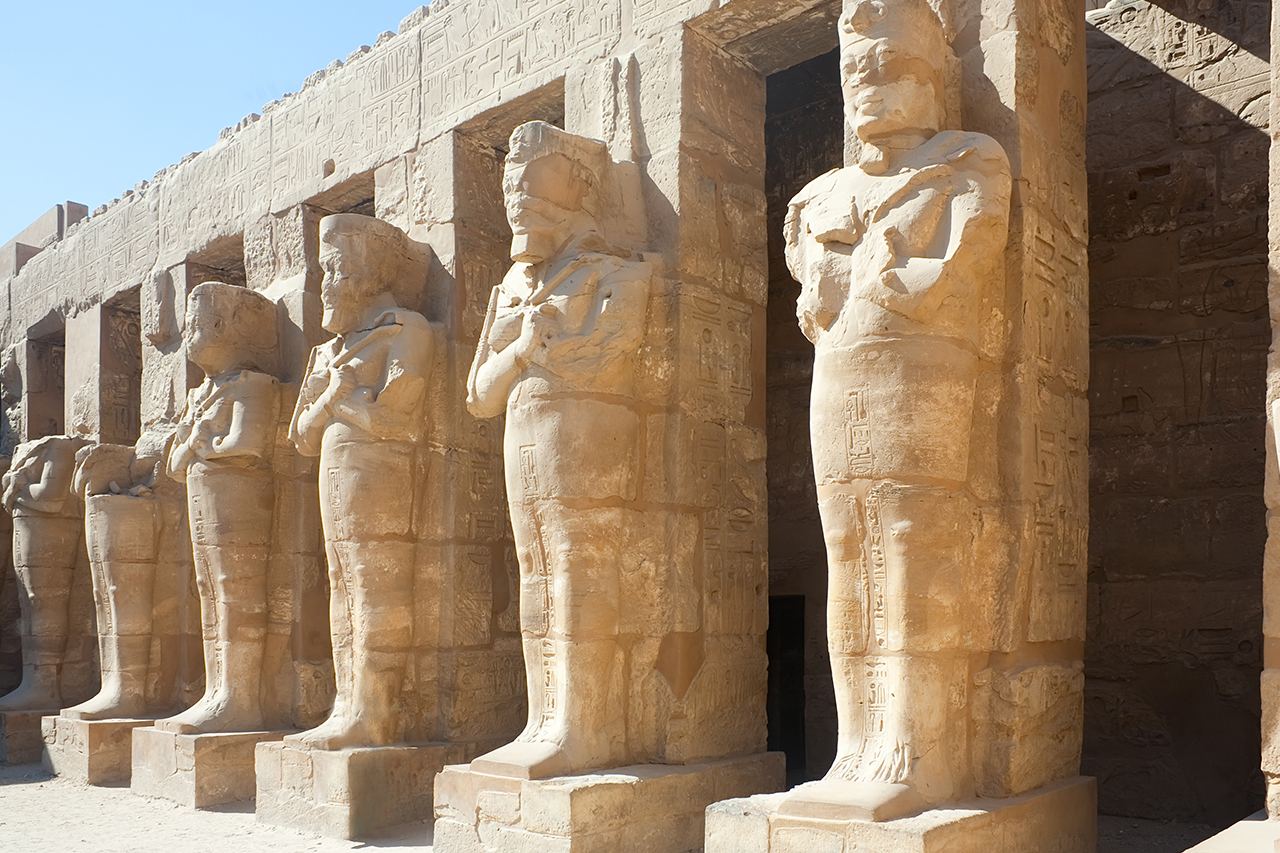Ancient Egpyt
Egypt’s natural links are in a northeasterly direction, following the Fertile Crescent up into western Asia. Similarly Ethiopia, the other early civilization of northeast Africa, is most influenced by Arabia, just across the Red Sea. So these two regions, Egypt and Ethiopia, flanked by desert to the west and equatorial jungle to the south, evolve at first in isolation from the rest of Africa.
But the development of maritime trade along the Mediterranean coast, pioneered by the Phoenicians in the 8th century BC, did increasingly bring Egypt into a specifically north African context.
After the desertification of the Sahara, settlement became concentrated in the Nile Valley, where numerous sacral chiefdoms appeared. The regions with the largest population pressure were in the Nile Delta region of Lower Egypt, in Upper Egypt, and also along the second and third cataracts of the Dongola Reach of the Nile in Nubia. This population pressure and growth was brought about by the cultivation of southwest Asian crops, including wheat and barley, and the raising of sheep, goats, and cattle. Population growth led to competition for farm land and the need to regulate farming. Regulation was established by the formation of bureaucracies among sacral chiefdoms. The first and most powerful of the chiefdoms was Ta-Seti, founded around 3,500 BC. The idea of sacral chiefdom spread throughout Upper and Lower Egypt.
Later consolidation of the chiefdoms into broader political entities began to occur in Upper and Lower Egypt, culminating into the unification of Egypt into one political entity by Narmer (Menes) in 3,100 BC. Instead of being viewed as a sacral chief, he became a divine king. The henotheism, or worship of a single god within a polytheistic system, practiced in the sacral chiefdoms along Upper and Lower Egypt, became the polytheistic Ancient Egyptian religion. Bureaucracies became more centralized under the pharaohs, run by viziers, governors, tax collectors, generals, artists, and technicians. They engaged in tax collecting, organizing of labor for major public works, and building irrigation systems, pyramids, temples, and canals. During the Fourth Dynasty (2,620–2,480 BC), long distance trade was developed, with the Levant for timber, with Nubia for gold and skins, with Punt for frankincense, and also with the western Libyan territories. For most of the Old Kingdom, Egypt developed her fundamental systems, institutions and culture, always through the central bureaucracy and by the divinity of the Pharaoh.
After the fourth millennium BC, Egypt started to extend direct military and political control over her southern and western neighbors. By 2,200 BC, the Old Kingdom’s stability was undermined by rivalry among the governors of the nomes who challenged the power of pharaohs and by invasions of Asiatics into the Nile Delta. The First Intermediate Period had begun, a time of political division and uncertainty.
Middle Kingdom of Egypt arose when Mentuhotep II of Eleventh Dynasty unified Egypt once again between 2041 and 2016 BC beginning with his conquering of Tenth Dynasty in 2041 BC.[91][92][93] Pyramid building resumed, long-distance trade re-emerged, and the center of power moved from Memphis to Thebes. Connections with the southern regions of Kush, Wawat and Irthet at the second cataract were made stronger. Then came the Second Intermediate Period, with the invasion of the Hyksos on horse-drawn chariots and utilizing bronze weapons, a technology heretofore unseen in Egypt. Horse-drawn chariots soon spread to the west in the inhabitable Sahara and North Africa. The Hyksos failed to hold on to their Egyptian territories and were absorbed by Egyptian society. This eventually led to one of Egypt’s most powerful phases, the New Kingdom (1,580–1,080 BC), with the Eighteenth Dynasty. Egypt became a superpower controlling Nubia and Judea while exerting political influence on the Libyans to the West and on the Mediterranean.
As before, the New Kingdom ended with invasion from the west by Libyan princes, leading to the Third Intermediate Period. Beginning with Shoshenq I, the Twenty-second Dynasty was established. It ruled for two centuries.
To the south, Nubian independence and strength was being reasserted. This reassertion led to the conquest of Egypt by Nubia, begun by Kashta and completed by Piye (Pianhky, 751–730 BC) and Shabaka (716–695 BC). This was the birth of the Twenty-fifth Dynasty of Egypt. The Nubians tried to re-establish Egyptian traditions and customs. They ruled Egypt for a hundred years. This was ended by an Assyrian invasion, with Taharqa experiencing the full might of Assyrian iron weapons. The Nubian pharaoh Tantamani was the last of the Twenty-fifth dynasty.
When the Assyrians and Nubians left, a new Twenty-sixth Dynasty emerged from Sais. It lasted until 525 BC, when Egypt was invaded by the Persians. Unlike the Assyrians, the Persians stayed. In 332, Egypt was conquered by Alexander the Great. This was the beginning of the Ptolemaic dynasty, which ended with Roman conquest in 30 BC. Pharaonic Egypt had come to an end.



